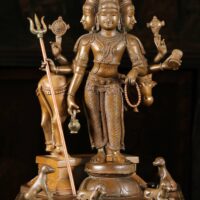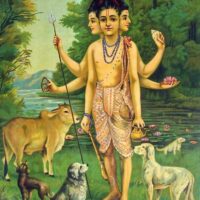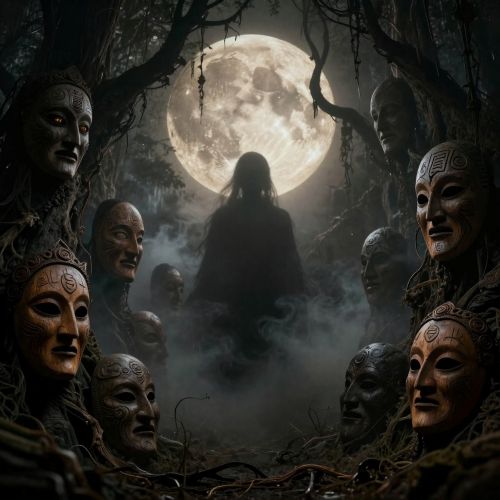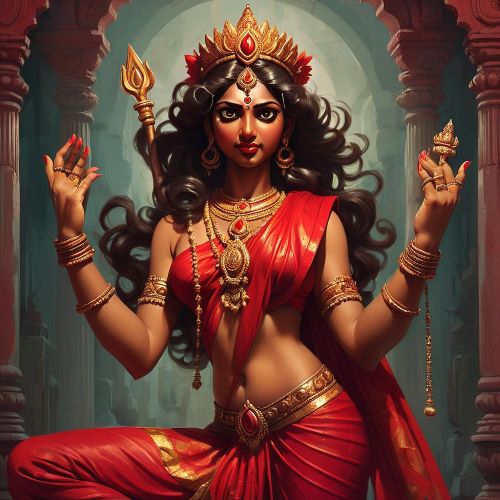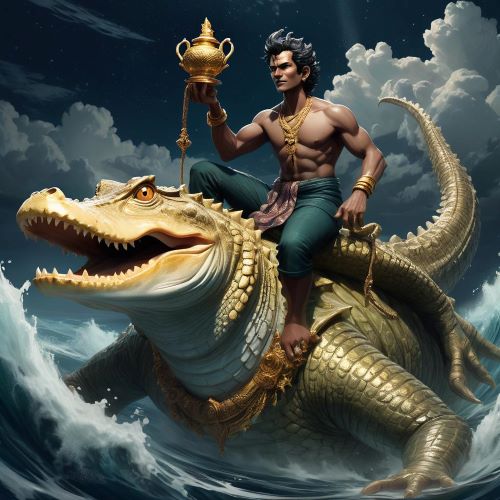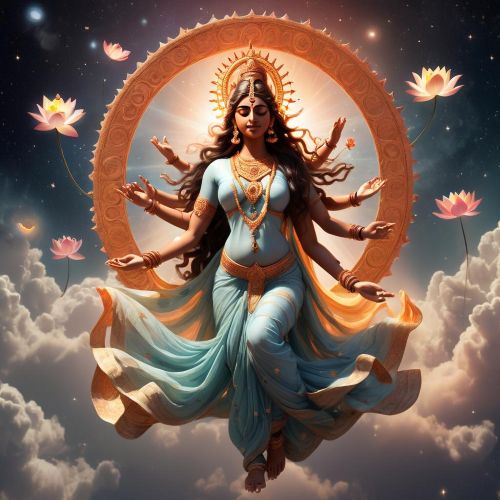Dattatreya : The Eternal Sage
Listen
At a glance
| Description | |
|---|---|
| Origin | Indian Mythology |
| Classification | Gods |
| Family Members | Atri (Father), Anasuya (Mother), Durvasa, Chandra (Brothers) |
| Region | India |
| Associated With | Spirituality, Teaching |
Dattatreya
Introduction
Dattatreya is one of the most intriguing and revered figures in Indian spirituality, embodying the essence of the Hindu trinity—Brahma, Vishnu, and Shiva—in a single form. Regarded as the universal teacher, he is often seen as the living principle of the Guru, guiding seekers beyond ritual into direct experience of truth. His teachings transcend the boundaries of sect and tradition, appearing not only in Hinduism but also in strands of Jain and Buddhist thought. Ancient scriptures such as the Avadhuta Gita, Dattatreya Upanishad, and references in the Puranas highlight his philosophy of detachment, non-duality, and experiential wisdom. Dattatreya is remembered for his unusual journey toward enlightenment, learning from twenty-four natural teachers—including animals, elements, and the rhythms of the world itself—each revealing the futility of attachment and the path toward freedom. For countless devotees, he remains a timeless symbol of yogic mastery and inner realization.
Physical Traits
Depictions of Dattatreya are rich in symbolism. His three heads represent the divine trinity—creation, preservation, and dissolution—signifying his all-encompassing nature. He is usually shown with six arms carrying objects linked to the Trimurti, such as a rosary, trident, discus, and water pot, blending their roles into a unified spiritual presence. A striking aspect of his iconography includes four dogs at his feet, symbolizing the four Vedas, while a cow accompanies him as a reminder of Mother Earth and the sustenance of dharma. His attire is simple, often just a loincloth, reinforcing his renunciation. Artists frequently place him in tranquil natural settings, surrounded by forests, rivers, and mountains, underscoring his deep connection with the natural world, from which he drew his profound insights. The serene smile across his faces suggests the harmony of multiple divine aspects existing within one being.
Family
The origins of Dattatreya are rooted in the pious household of Sage Atri and his virtuous wife Anasuya. Both are highly venerated in Hindu tradition, Atri as one of the seven great sages (Saptarishis) and Anasuya as a paragon of devotion and chastity. Legends recount that the Trimurti—Brahma, Vishnu, and Shiva—were so moved by Anasuya’s virtue that they granted her a boon, merging their divine essence into a single child: Dattatreya. He was not the only remarkable offspring of this sacred union. His brothers include Durvasa, known as an incarnation of Shiva famous for his fiery temper, and Chandra, the moon god associated with Brahma’s creative energy. This divine family lineage highlights how Dattatreya was born not merely as a saint but as a cosmic figure carrying the essence of multiple deities.
Other names
Dattatreya is revered under many epithets, each reflecting a dimension of his nature and teachings. The name “Datta” translates to “given,” symbolizing him as a divine gift to humanity, while “Atreya” emphasizes his connection to Sage Atri. In yogic and ascetic traditions, he is called Avadhut, the one who has renounced worldly attachments entirely. Another name, Digambara, meaning “sky-clad,” points to his transcendence of material coverings and conventions. He is also hailed as Siddhipati, master of mystical and spiritual powers, and Mahāyogi, the great yogi embodying the highest form of meditation and self-realization. In many traditions, devotees address him simply as Guru, the eternal teacher guiding seekers through the complexities of life toward liberation. These names are not merely titles but encapsulations of his many roles—as deity, ascetic, yogi, and spiritual preceptor.
Powers and Abilities
As an embodiment of the Trimurti, Dattatreya holds extraordinary powers that transcend ordinary human comprehension. He unites the creative force of Brahma, the sustaining energy of Vishnu, and the transformative power of Shiva, making him a complete expression of divine functions. Scriptures describe him as omniscient, aware of all realms of existence, and capable of appearing anywhere at will, a power known as Prapti. His command over yogic siddhis includes mastery over time, space, and natural laws, enabling feats such as telepathy, shape-shifting, and miraculous healing. He is also associated with protection, shielding devotees from harmful forces, black magic, and negative entities. His role as the supreme guru extends beyond the supernatural; he embodies spiritual wisdom itself, often teaching through silence, paradox, or unexpected encounters. Central to his philosophy is the idea that true knowledge comes from seeing the divine in all things, a principle he illustrated through his 24 natural teachers.
Modern Day Influence
The influence of Dattatreya extends far beyond the pages of scripture and continues to inspire spiritual practices in the modern world. His worship thrives particularly in western India, in regions such as Maharashtra, Gujarat, and Karnataka, where temples and pilgrimage sites like Ganagapur and Narayanpur attract thousands of devotees. The Nath tradition and Avadhut sampradayas regard him as the primal guru, with many saints—such as Shirdi Sai Baba, Swami Samarth of Akkalkot, and Gajanan Maharaj—considered his manifestations or followers. His teachings of simplicity, detachment, and service resonate strongly in contemporary times, where spiritual seekers are increasingly drawn to paths beyond rigid dogma. Academic works, including Antonio Rigopoulos’s detailed study Dattātreya: The Immortal Guru, Yogin, and Avatāra, examine his evolution from ancient mythological figure to living spiritual archetype. His image appears in devotional music, art, literature, and even modern discussions on yoga and self-realization. By emphasizing contemplation, compassion, and recognition of divinity in all beings, Dattatreya’s message continues to provide guidance in an age of complexity and distraction.
Related Images
Source
Dattapeetham. (n.d.). Sri Ganapathy Sachchidananda Swamiji – Dattatreya lineage and teachings. Retrieved August 16, 2025, from https://www.dattapeetham.org
Shripad Shri Vallabh. (n.d.). Life and teachings of Shripad Shri Vallabh – First incarnation of Dattatreya. Retrieved August 16, 2025, from https://www.shripadshrisvallabh.com
Hindupedia. (n.d.). Dattatreya. Retrieved August 16, 2025, from https://www.hindupedia.com/en/Dattatreya
Wisdom Library. (n.d.). Dattatreya: Definition and references in Sanskrit texts. Retrieved August 16, 2025, from https://www.wisdomlib.org/definition/dattatreya
Speaking Tree. (n.d.). The significance of Lord Dattatreya in Hinduism. Retrieved August 16, 2025, from https://www.speakingtree.in/allslides/the-significance-of-lord-dattatreya-in-hinduism
Exotic India Art. (n.d.). Iconography and symbolism of Dattatreya. Retrieved August 16, 2025, from https://www.exoticindiaart.com/article/dattatreya
Frequently Asked Questions
What is lorem Ipsum?
I am text block. Click edit button to change this text. Lorem ipsum dolor sit amet, consectetur adipiscing elit. Ut elit tellus, luctus nec ullamcorper mattis, pulvinar dapibus leo.
What is lorem Ipsum?
I am text block. Click edit button to change this text. Lorem ipsum dolor sit amet, consectetur adipiscing elit. Ut elit tellus, luctus nec ullamcorper mattis, pulvinar dapibus leo.
What is lorem Ipsum?
I am text block. Click edit button to change this text. Lorem ipsum dolor sit amet, consectetur adipiscing elit. Ut elit tellus, luctus nec ullamcorper mattis, pulvinar dapibus leo.
What is lorem Ipsum?
I am text block. Click edit button to change this text. Lorem ipsum dolor sit amet, consectetur adipiscing elit. Ut elit tellus, luctus nec ullamcorper mattis, pulvinar dapibus leo.
What is lorem Ipsum?
I am text block. Click edit button to change this text. Lorem ipsum dolor sit amet, consectetur adipiscing elit. Ut elit tellus, luctus nec ullamcorper mattis, pulvinar dapibus leo.


